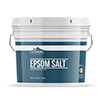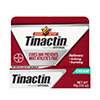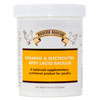Vent Gleet In Chickens: Causes And Treatment
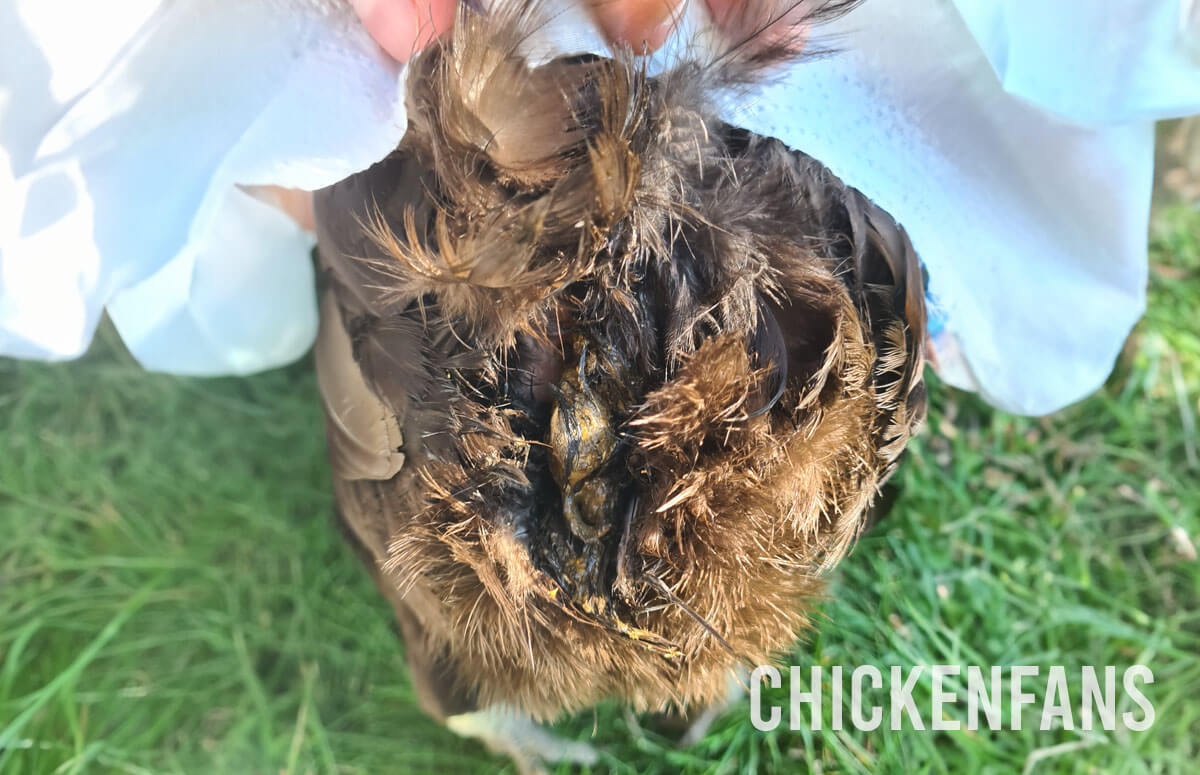
Chicken Fans is reader-supported. When you buy through our links, we may earn a commission. Learn more about our privacy policy and disclaimer.

You’ve probably seen a fair share of nasty situations as a backyard chicken keeper. One particularly unpleasant scenario in chickens is vent gleet. Their otherwise fluffy butt is all cluttered and has a nasty smell.
We will closely examine vent gleet – its causes, risk factors, signs & symptoms, treatment options, and prevention.
What Is Vent Gleet In Chickens?
Vent gleet in chickens is a fungal infection of the cloaca, usually caused by the fungus Candida albicans. The medical term is cloacitis, meaning inflammation of the cloaca, the opening from which chickens pee, poop, and lay eggs. The butt feathers are dirty, foul-smelling, and often cluttered from diarrhea.
It’s not always immediately obvious that something is going on if your chickens have feathery butts. Only when the outer feathers start to clutter it becomes easy to spot. Here is one of our chickens suffering from vent gleet, so you know what to look for.
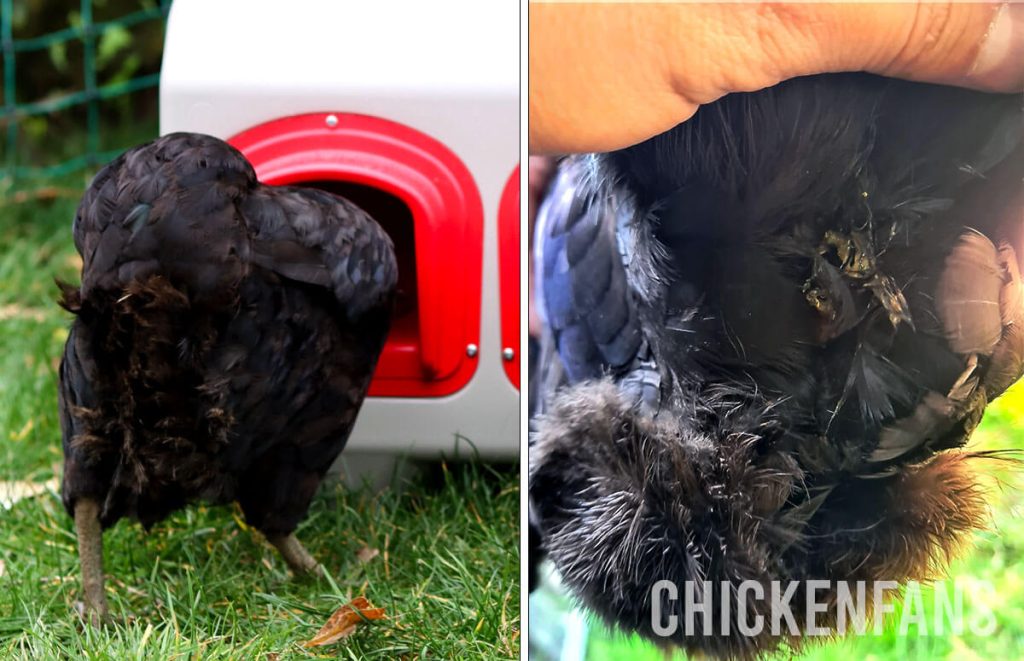
What Causes Vent Gleet In Chickens?
Vent gleet in chickens is caused by Candida albicans overgrowth. C. albicans is a fungus that normally lives in small numbers in the chicken’s gut. If there is an imbalance between the “good” and “bad” microorganisms in the gut, the C. albicans population is likely to overgrow, causing vent gleet.
Risk factors that contribute to gut imbalances and vent gleet include:
- Stress: Chickens are exposed to a number of stress triggers, such as egg laying, heat, poor hygiene, barnyard squabbles, molting, etc.
- Moldy Food: Moldy chicken food (corn, grains, nuts) contains mycotoxins and introduces new fungi into the bird’s gut.
- Contaminated Water: The water can be contaminated from the source or get dirty if kept in barrels covered with slime and algae.
- Wet Conditions: The common culprit is soiled, non-waterproof bedding. Proximity to wet spots like compost piles is also problematic.
- Poor Hygiene: Low hygiene adds to the overall wetness. Plus, it supports the growth of bad bacteria that can throw the chicken’s gut out of balance.
- High-Carb Diets: High-carb diets low in fiber increase glucose levels in the body, thus creating favorable conditions for fungal overgrowth.
- Antibiotic Use: Long courses and frequent use of antibiotics kill both bad and good bacteria in the gut, thus creating imbalances.
How Does Vent Gleet In Chickens Manifest?
The telltale sign of vent gleet in chickens is a whitish and foul-smelling discharge around the cloaca. The vent gleet discharge is characterized by:
- Color: It is usually white, but depending on the circumstances, can have a yellowish note. A greenish color is possible if severe.
- Consistency: Can be thin and watery or thick and creamy. In some cases, it is even described as cheesy.
- Smell: It has a repulsive scent similar to fermenting yeast. In the advanced stages, it can smell like rotten eggs.
Other signs of chicken vent gleet include:
- Red and swollen vent
- Soiled vent feathers
- Missing feathers around the vent
- Diarrhea (watery, slimy, and often bloody droppings)
- Reduced appetite
- Decreased egg production
Treatment For Vent Gleet In Chickens
For simple cases of vent gleet, at-home treatment is possible – you just have to know what to do and what not to do.
Here is a short overview of the vent gleet treatment steps.
1. Quarantine the Chicken
Isolate the chicken in a clean and stress-free environment. Chickens are curious and may peck the sick chicken at the vent, thus making things worse. Plus, providing treatment and monitoring progress will be easier if the chicken is separated from the rest.
2. Trim the Vent Feathers
The vent feathers will constantly get dirty and contribute to skin irritation. It is best to clip them to support hygiene. Just be careful not to snip them too close to the skin, as this can be painful for the chicken.
3. Clean the Vent Area
Then, soak the chicken in warm water with two tablespoons of Epsom salt. The soaking should be 10-15 minutes long and can be repeated every other day. You must dry the chicken well after the bath.
Here is an example of one of our chickens with vent gleet during the cleaning phase. You can see what the vent looks like after we’ve removed most of the heavy dirt. You can see how we’ve opened up the vent area from clutter.
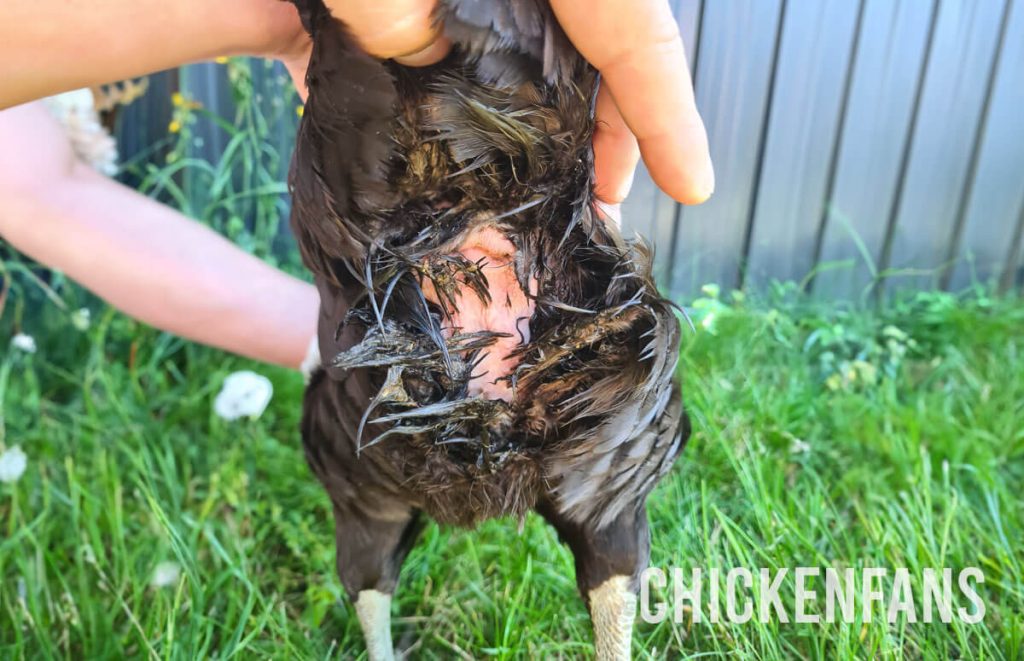
Don’t worry about the feathers. They will get back to normal when they dry.
4. Perform a Flush
When the digestive system slows downs, the decomposing retained food serves as a nutrient source for the fungus. To eliminate this issue, you can perform an oral flush (one flush per episode is enough). For the flush, use the following:
- 1 cup of molasses in 3 gallons of water
- 1 tablespoon of molasses in a cup of applesauce
- 1 teaspoon of Epsom salt in an ounce of water
5. Use Oral & Topical Antifungals
Give the chicken oral Nistatin suspension for seven to ten days. Nistatin is a prescription medicine. You can also apply over-the-counter antifungal creams to the vent. Commonly used antifungal creams are Canesten and Monistat.
6. Add Probiotics to their Menu
Probiotics are an excellent way of promoting the growth of healthy bacteria in the gut. You can use commercial probiotic supplements or give foods naturally rich in probiotics, like yogurt (do not overfeed, as yogurt can cause diarrhea).
For more info and guidance on what probiotics are the best for chickens, check our probiotics for chickens guide.
What NOT to do When Treating Vent Gleet in Chickens
Knowing what not to do is equally vital. With that said, when treating a chicken with vent gleet:
- Do NOT use antibiotics. Antibiotics kill bacteria regardless of whether they are good or bad, which adds to the already imbalanced gut.
- Do NOT use Vetericyn. Vetericyn is formulated for skin and wound care and may not be ideal for a chicken’s vent area.
- Do NOT use tea tree oil. Tea tree oil contains natural terpenes, which can be toxic to birds.
- Do NOT give high-water food. Fruits and veggies with high water content contribute to the already present diarrhea.
Preventing Vent Gleet In Chickens
Vent gleet in chickens is not 100% preventable. The good news is that you can decrease the risk of vent gleet if you:
- Maintain excellent hygiene in the environment
- Use highly absorbent bedding in the coop
- Provide high-quality feed for the chickens’ needs
- Ensure there is clean and fresh drinking water at all times
- Supplement with probiotics for maximum gut health
- Minimize stress exposure as much as possible
Conclusion: Vent Gleet In Chickens
Vent gleet in chickens looks nasty and smells even worse. However, despite the striking clinical manifestation, it is very treatable, especially when caught early.
If dealing with a case of vent gleet for the first time, it is best to consult a licensed vet. If you are experienced, you will be able to manage the issue on your own.
Remember, responsible backyard chicken keeping (high-quality diet, excellent hygiene, no stress) goes a long way in decreasing the risk of vent gleet in a flock.
Frequently Asked Questions
No, vent gleet in chickens is not contagious. However, it is likely to occur in more chickens simultaneously. This is because the risk factors are the same for all flock members.
No, vent gleet in chickens is not life-threatening. However, if left untreated, it may trigger complications such as sour crop – which can be fatal. Chickens with vent gleet also have decreased egg production.
The usual recovery time for vent gleet is seven days, but in most cases, there will be an improvement within three days. If the treatment is delayed, it can take up to three weeks for the vent gleet to resolve.
Yes, you can eat the eggs from chickens with vent gleet, provided no antibiotics are used in the treatment. Also, keep in mind that egg production drops during vent gleet episodes.

Dr. I. Crnec is a licensed veterinarian with several years of experience. She has published work on the effect of vitamin supplementation, egg-laying performances of chickens under heat-stress conditions and the effects of calcium supplementation on eggshell strength.
